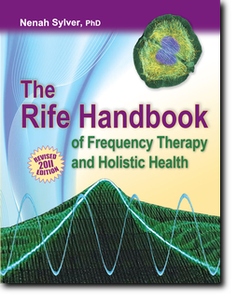Thyroid Section
.
the Chapter 5
Frequency Directory
Thyroid Gland Section
from
The Rife Handbook
of Frequency Therapy
and Holistic Health
(2011 Revised Edition)
by Nenah Sylver, PhD

The thyroid is a butterfly-shaped gland in the throat with most of its mass on either side of the central Adam’s apple. The gland produces thyroxin (also known as T4), liothyronine (also known as T3), T2, and T1. T4, the most well known of all the thyroid hormones, and T3, the most active form of thyroid hormone, heat the body and speed metabolism and heart rate. At best, T4 is only about one-quarter as potent as T3; and in any case, most is converted into the more active T3 by the liver, kidneys and other body cells. T2 stimulates metabolism, while one animal study showed that T1 cools the body and slows the heart. Together, all four of these related hormones very likely act synergistically in ways that are not yet fully understood.
The thyroid influences, and is influenced by, other parts of the endocrine system: the adrenals, pituitary, parathyroid and sex glands, as well as the hypothalamus. If one side of the thyroid gland under-functions, the other side may over-function to compensate.
Conventional medicine teaches that thyroid hormone production depends on a complex feedback loop involving other parts of the endocrine system. The process starts in the hypothalamus portion of the brain. The hypothalamus releases TRH (thyrotropin releasing hormone) to stimulate the pituitary gland in the brain’s center. The pituitary monitors blood thyroid hormone levels. If there’s not enough thyroid hormone in the blood, the pituitary secretes TSH (thyroid stimulating hormone) to induce the thyroid gland to produce more hormone. After the pituitary detects enough thyroid hormone in the bloodstream, it decreases production of TSH so the thyroid produces less hormone.
The problem with this ideal scenario is that even with normal blood levels of thyroid hormone, one can still suffer from symptoms of a malfunctioning thyroid, usually underactivity. See the rest of this section for details.
Proper thyroid performance is essential for the normal functioning of cells, the nervous system and muscles, and heavily impacts proper brain development, oxygen utilization, immunity and metabolism. Metabolism includes growth and development, and the speed and efficiency with which the body takes in nourishment and eliminates waste products.
About one-third of the Earth’s population live in iodine-deficient areas as defined by the World Health Organization. The rise in thyroid disorders correlates with these areas. Iodine helps the body synthesize, store and secrete thyroid hormone. It also coats incoming allergenic proteins to make them non-allergenic, helps protect the system against cancer and autoimmune diseases, and is an antiseptic. In the stomach, iodine deactivates all biological—and most chemical—poisons. Many holistic authorities now say that iodine is required daily in milligram, rather than microgram, amounts. Although the mineral in its iodine form is utilized most effectively by the tissues, potassium iodide is particularly needed by the thyroid gland; so if you aren’t getting enough of both in your diet (sea food and seaweed are excellent sources), supplement with liquid or tablets.
A number of substances should be avoided, as they severely disrupt thyroid function. Fluoride interferes with the body’s ability to utilize iodine. Goitrogenous vegetables—including the brassica family (Brussels sprouts, cabbage, cauliflower and mustard greens), and rutabagas, radishes and turnips—interfere with thyroid hormone production when eaten raw and in large amounts. (Boil the vegetables to destroy the thyroid-inhibiting compounds.) Estrogenic compounds (which also interfere with immune response) are present in hormone-disrupting drugs, plastics, and soy (see Chapter 3 for more information). Animals raised for food that eat even organic soy can cause thyroid problems as well. For any type of thyroid condition, eat protein at every meal, and eat at regular hours, especially if your blood sugar levels tend to drop. Also, make sure you get enough Coenzyme Q10, tyrosine (an amino acid), Vitamins B1, B2, B3 and B5, and the minerals magnesium, iron, zinc, copper, selenium and iodine.
Goiter
Goiter—which is enlarged thyroid gland tissue— can grow to be the size of tennis balls or larger. Conventional medicine teaches that goiter results from undesirably high levels of TSH (thyroid stimulating hormone) produced by the pituitary, which in turn prods the thyroid gland into producing excessive amounts of thyroid hormone and thus causes the gland to grow abnormally. However, some people with goiter show normal thyroid hormone and TSH tests. If there’s not enough iodine in the diet, the thyroid will be unable to produce enough hormone. Thus, insufficient dietary iodine can cause the thyroid to grow unnaturally, due to the pituitary’s continued high production of TSH in its attempt to raise thyroid hormone levels.
Outside the United States, authorities recognize that goiter is generally due to an iodine deficiency. In fact, goiter is not as prevalent in populations living at or near a seacoast. Until recently, for 200 years goiter was treated successfully with the administration of Lugol’s solution (potassium iodide) and desiccated thyroid. Eat plenty of iodine-rich real sea salt and/or sea food. Kelp supplements may also help. However, do not overdose on iodine either, as this can be as damaging as too little.
Goiter may also be caused or exaggerated by microbial infection, so use the frequencies below. A popular frequency for supporting thyroid function is 160. Incidentally, goiter is often the most common manifestation of a larger constellation of conditions, one of which is Graves’ or Basedow’s disease.
If related to Struma cystica (swelling involving cysts): 361, 531, 756, 5311
If related to Struma parenchyma (swelling involving the kidneys) or to Struma nodosa: 105, 121, 122, 321, 517, 532, 576, 651, 714
If due to other causes: 20, 160, 660 + 690 + 727.5, 787, 880, 16K
Graves’ Disease / Basedow’s / Diffuse Toxic Goiter
Graves’ disease—named after the Irish physician who described it in the London Medical Journal in 1835—is called "Basedow’s disease" in Europe, and "thyrotoxicosis" worldwide. The term "diffuse toxic goiter" describes the condition rather than the discoverer. "Diffuse" refers to the entire gland involved in this condition. "Toxic" describes a condition reminiscent of infection and fever. "Goiter" is an abnormally large thyroid gland.
The most common cause of hyperthyroidism in Canada, Graves’ affects about one in every 100 people. This inherited disease is more common in females than in males. In addition to all the symptoms listed above for general hyperthyroidism, symptoms also include muscle weakness, thyroid enlargement (goiter), and eye problems, including sensitivity to light, diminished vision, and double vision. The inflamed eyeball tissue gives the eyes the familiar bulge characteristic of this disorder.
Graves’ is an autoimmune-related form of hyperthyroidism (although not everyone who is hyperthyroid has Graves’). In an immune-healthy body, lymphocytes (lymph immune cells) as well as Killer (K) Cells target and destroy pathogens. They also prevent the production of harmful thyroid stimulating (and other abnormal) antibodies. But with immune-impaired Graves’, the lymphocytes and K Cells do not function properly. They produce abnormal thyroid-stimulating antibodies, which attack proteins on the surface of thyroid cells. In response, the thyroid cells produce too much hormone, which in turn over-stimulates the thyroid. (The swelling of skin, eyes, or other body parts is caused by antibodies attacking the body’s own tissues.) Even if most of the thyroid gland is removed, it can still become overactive again since the abnormal thyroid stimulating antibodies—which caused the hyperactivity in the first place—are still being produced by the lymphocytes. Often, symptoms of Graves’ intensify and then disappear.
Allopathic doctors treat an over-stimulated thyroid in three ways: surgery (removal of most of the thyroid gland), drugs (which either suppress thyroid hormone production or block the effects of excess hormone on the heart, blood vessels and nervous system), and destruction of the gland (with radioactive iodine). A thyroidectomy is critical for people in whom the goiter is so large, that it threatens to block the windpipe (trachea) or food passage (esophagus). About 80% of those who receive the radioactive iodine become hypothyroid, and are typically given thyroxin supplementation for the rest of their lives.
Sometimes people manage Graves’ with acetyl- an amino acid compound that makes cells in the body resistant to thyroid hormone and helps correct the immune response. New evidence suggests that minute amounts of (non-radioactive) iodine may also help, since the thyroid gland tends to overwork (and then quits working altogether) when it does not receive sufficient nutritional support. In some cases iodine makes the condition worse, although this is usually a temporary setback. As this is an immune response problem (which happens to manifest in the thyroid gland), see a qualified health practitioner!
There are no frequencies for Graves’ per se. See "Hashimoto’s Disease / Autoimmune Thyroiditis" and other entries in this Thyroid section; Autoimmune Disorders; and Chemical Poisoning / Detoxification. Also see the myriad pathogens implicated in autoimmune thyroid conditions: "Coxsackie B" under Viruses; "Mycoplasma, many types" under Bacteria; "E. coli / Escherichia coli" under Bacteria; and "Helicobacter pylori / Peptic (Stomach) Ulcer" under Bacteria. Yersinia enterocolitica has also been implicated in autoimmune thyroid disorders, so also see "Yersinia infections, other (unspecified)" under Bacteria.
Hashimoto’s Disease / Autoimmune Thyroiditis
Hashimoto’s is a chronic autoimmune condition, caused by abnormal antibodies in the bloodstream, that attack and destroy healthy thyroid gland tissue. As a result, the gland does not produce enough hormone. In most cases, symptoms are similar to those of hypothyroidism: fatigue, forgetfulness, dry brittle hair, hoarseness, painful and stiff joints, muscle weakness, face swelling, sensitivity to cold, pale dry skin, weight gain, constipation, muscle cramps, depression, and (with women) possible menstrual disorders.
Sometimes, Hashimoto’s develops in response to a lack of iodine, whereby the thyroid swells (a condition known as goiter) in its effort to filter more blood to obtain the iodine it needs. If iodine is then ingested, the now larger thyroid gland increases thyroid hormone production. This sometimes accounts for the occasional swings between thyroid underactivity and thyroid overactivity. Mostly, however, the thyroid gland gradually atrophies, either becoming underactive or ceasing to function altogether.
Allopathic treatment consists of synthetic thyroid hormone. A holistic approach may provide natural glandular support and suggest supplements, including transfer factor and glutathione (to regulate immune function), Vitamin D, and fish oil. If copper is replenished, the body may correctly process iodine.
Avoid glutinous grains! In Why Do I Still Have Thyroid Symptoms, Dr. Datis Kharrazian cites research showing that the molecular structures of gluten and the thyroid gland are similar enough so that gluten in the digestive tract will almost inevitably trigger the body to attack the thyroid. (See the Food section in Chapter 3 for more information on grains.)
There are no known frequencies for Hashimoto’s. See "Graves’ Disease / Basedow’s / Diffuse Toxic Goiter" and other entries in this Thyroid section; Autoimmune Disorders; and Chemical Poisoning / Detoxification. Also see the myriad pathogens implicated in autoimmune thyroid conditions: "Coxsackie B" under Viruses; "Mycoplasma, many types" under Bacteria; "E. coli / Escherichia coli" under Bacteria; and "Helicobacter pylori / Peptic (Stomach) Ulcer" under Bacteria. Yersinia enterocolitica has also been implicated in autoimmune thyroid disorders, so also see "Yersinia infections, other (unspecified)" under Bacteria.
Thyroid, to Balance and Normalize
First try: 160, 763, 660 + 690 + 727.5 Then try: 20, 537, 1570, 10K, 16K
Thyroid Gland Fever
20, 160, 660 + 690 + 727.5, 1570, 10K, 16K
Thyroid, Overactive / Hyperthyroidism
Overactivity of the thyroid gland, which causes too much thyroid hormone to be produced. Since the thyroid controls many body functions, increased levels can be serious. Symptoms can include weight loss, profuse perspiration, and sleeplessness (due to increased metabolism); irregular heartbeat, high blood pressure, chest pain, and even heart failure (because the circulatory system is working faster); and even diarrhea (due to increased bowel function). The over-stimulated nervous system causes irritability, nervousness, jitteriness, emotional angst, and mental disorientation. Despite increased appetite, the person usually loses weight because the increased breakdown of body proteins occurs too rapidly to be replenished by food.
Hyperthyroidism can be caused by Graves’ disease (a faulty autoimmune response), nodules or goiters on the thyroid, excessive thyroid medication given to people with an underactive thyroid, iodine toxicity (too much iodine or an intolerance to certain forms of iodine), or thyroiditis (inflammation of the thyroid). This is not something to self-treat! See a health care practitioner.
0.5, 3, 20, 160
Thyroid, Underactive / Hypothyroidism
"Hypothyroidism" may be regarded as a catch term that describes both underactivity of the gland itself, and the inability of the body to utilize thyroid hormone. In either case, the symptoms are the same. Malfunctions in metabolism accompany impaired temperature regulation. This manifests in weight gain or (occasionally) weight loss, along with heat intolerance and excessive coldness—particularly in extremities where there’s impaired circulation. (Not only does the person subjectively feel chilly, but the hands and feet feel cold to another person’s touch.) The body also has difficulty repairing damaged tissues. This is why so many hypothyroid people suffer from structural weaknesses: brittle nails, brittle or scant hair (including baldness), degenerating bones (osteoporosis), malformed bones (scoliosis), and thinning and loss of eyebrows, notably the outer third. Physical signs of hypothyroidism also include puffy face and lips, dry skin, fatigue and lethargy, and slowed movements and speech.
Since thyroid hormones are intricately related to virtually every bodily function, hypothyroidism can cause or exacerbate an almost unlimited number of conditions that initially might not seem related to each other: autoimmune conditions (such as allergies, lupus and rheumatoid arthritis), blood sugar disorders, cancers, cardiovascular disturbances (including coronary artery disease and congestive heart failure), dental problems (including chronic gum infections and Temporomandibular Joint dysfunction), gastrointestinal disorders, hoarseness, sleep apnea, immune response malfunction leading to increased infections (such as Candida albicans), mental and emotional problems (including confusion, depression and mood swings), neurological impairment (including Multiple Sclerosis, deafness, tinnitus and vertigo), headaches and migraines, pain in joints and muscles (including arthritis, carpal tunnel syndrome and fibromyalgia), reduced perspiration, reproductive disorders (such as birth defects, endometriosis and infertility), respiratory conditions (including asthma, pneumonia and chronic sinus infections), skin disorders, and urinary tract problems (including infections, and kidney failure due to scarred shrunken kidneys).
Hypothyroidism was first reported in London in 1875. According to many reliable sources, including doctors Broda Barnes, David Derry, Jacques Hertoghe and James Howenstine, at least one-third to one-half of the US population suffers from slight to severe hypothyroidism. In Hypothyroidism Type 2: The Epidemic, Dr. Mark Starr explains the differences between Types 1 and 2 hypothyroidism. With Type 1, the thyroid does not produce sufficient amounts of hormone to maintain "normal" blood levels of hormones (which in turn maintain normal blood levels of thyroid-stimulating hormone, or TSH, produced by the pituitary). With Type 2, the thyroid gland produces "normal" amounts of hormone, but the cells are unable to utilize the hormone properly. Some experts call this thyroid hormone resistance, which may be regarded as similar to insulin resistance.
The body fails to accept or utilize thyroid hormone for many reasons. The mitochondria—microscopic energy-burning units of the cell responsible for about 90% of our energy production that all cells and tissues need for metabolism—are impaired. Mitochondrial defects, which interfere with every aspect of thyroid metabolism, are usually caused by environmental toxins, including petroleum, pesticides, organic solvents and heavy metals, especially mercury. (Fat-soluble toxins lodge in the fat cells, and women’s bodies contain more fat than men’s; so a greater number of women suffer from hypothyroidism than do men.) Faulty thyroid receptors on the cell membranes can also cause hypothyroidism by making it impossible for enough hormone to enter the nucleus, where genes are activated and protein synthesis occurs. Finally, abnormally high levels of mucin cause disease conditions in over 55% of hypothyroid subjects. Mucin is a sugar-protein compound that readily absorbs water and is normally present in different types of connective tissue everywhere in the body: in the lining of blood vessels, in the nerve sheaths, in the fascia enveloping the muscles, in mucous membrane linings of the respiratory tract (such as the sinuses), and in the gastrointestinal and urinary tracts—not to mention every single cell in the organs and glands. When present in normal amounts, mucin is not a problem; but in excess, it damages the connective tissue wherever it accumulates. This helps explain the diversity of serious hypothyroidism-related conditions, which include Lupus and congestive heart failure.
Inadequate thyroid hormone at the cellular level also negatively impacts other glands. To compensate for the weakness and low metabolism caused by inadequate thyroid hormone, other parts of the body overwork (especially the adrenals, and even including the sympathetic nervous system). This may cause the subject to temporarily experience a rapid heartbeat, and/or feel hyperactive, jittery and restless—until exhaustion sets in from the unnatural attempts to compensate for low thyroid hormone levels. More often, though, the majority of sufferers simply feel fatigued and weak most of the time. This is why it’s important to support other organs and glands (especially the adrenals) when treating hypothyroidism.
Hypothyroidism can be catalyzed or exacerbated by constant low temperatures, and a diet heavy in carbohydrates, gluten, dairy, and especially soy. A healthy thyroid gland can also become sluggish due to radiation exposure from nuclear bomb "testing" or X-rays: radiation creates radioactive iodine, which then displaces the non-radioactive iodine that naturally feeds the thyroid gland.
Laboratory tests showing inadequate bloodstream levels of thyroid hormone make it easy to diagnose Type 1 hypothyroidism. However, lab tests fail to detect Type 2 hypothyroidism because despite adequate blood hormone levels, the body cannot accept and utilize the hormone. Therefore, the best hypothyroidism test (developed by Dr. Barnes) is to take the armpit temperature before rising every day, over a week or more. If the temperature averages lower than 97.8ºF (about 36.6ºC), the person is hypothyroid. One could be hypothyroid with a near-normal basal temperature; but this test is still the most accurate diagnostic tool. Of course, one’s symptoms and clinical picture are the definitive test.
Hypothyroidism usually requires medication, and the proper kind! Prolonged administration of synthetic thyroxin (T4) is the least effective, and may shut down the gland entirely. The most effective treatment is whole desiccated thyroid (from pigs) made from the entire gland and its contents: all forms of thyroid hormone, RNA and DNA, and co-factors (which all work synergistically with each other). An alternative is compounded T3 and T4, in the same ratio as that of a functioning gland. Even if lifelong treatment is required, at least the person will feel better and function well.
The fact that a good portion of the T4 to T3 conversion takes place in the liver also points to the need for a good liver detox protocol. An excellent means of detoxifying is sauna therapy. Sweating reduces the waste removal burden on the kidneys, liver, and eliminative organs. See my book, The Holistic Handbook of Sauna Therapy.
Different forms of iodine are essential for optimal functioning. Potassium iodide is absorbed by the thyroid gland, whereas iodine is heavily concentrated in the breasts, reproductive organs and respiratory tract (including sinuses). Some seaweeds, such as dulse, are high in iodine.
To assist in the conversion of T4 to T3, supplement with selenium, zinc, and Vitamins E and B6. Manganese, known to protect the thyroid and liver, is sometimes called the "anti-pear nutrient," so named because it helps eliminate the weight distribution pattern (disproportionately heavy hips and thighs) common with hypothyroid people. Proper thyroid hormone synthesis also requires increased vitamin intake. Read Solved: The Riddle of Illness, and see a holistic medical doctor. Often, other glands in a delicate balance with the thyroid are involved, such as the adrenals, sex glands and pituitary.
7.7, 12, 20, 35, 160, 740, 802 + 1550, 16K
Thyroiditis
Inflammation of the thyroid gland, generally occurring after a viral infection or pregnancy. Many viruses and bacteria may cause the condition, so see other entries in this section and use frequencies for any infectious illnesses you may have contracted within the last six months to two years. Also see "Rubulavirus / Mumps" under Viruses, since that microorganism may cause thyroiditis; and "Mycoplasma, many types" under Bacteria. Also see "Rubulavirus / Mumps" under Viruses, since that microorganism may cause thyroiditis.

from





